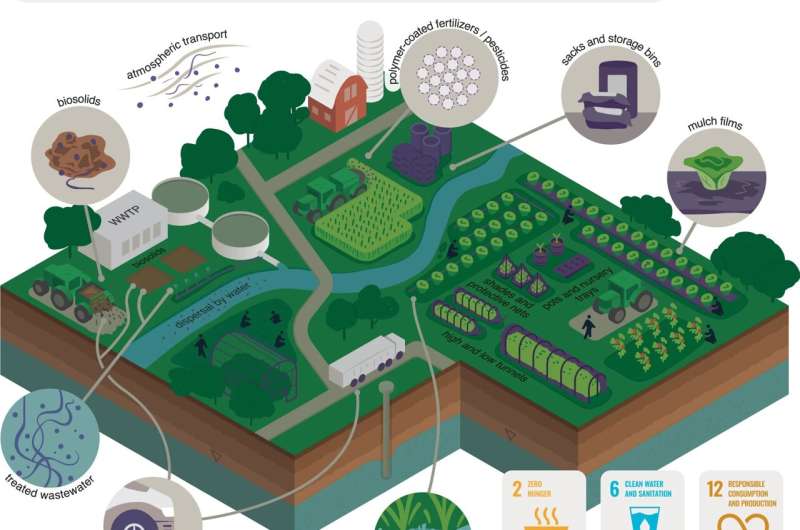This article has been reviewed according to Science X's editorial process and policies. Editors have highlighted the following attributes while ensuring the content's credibility:
fact-checked
peer-reviewed publication
trusted source
proofread
How can the use of plastics in agriculture become more sustainable?

It is impossible to imagine modern agriculture without plastics. 12 million tons are used every year. But what about the consequences for the environment? An international team of authors led by Thilo Hofmann from the Division of Environmental Geosciences at the University of Vienna addresses this question in a recent study in Communications Earth & Environment. The research shows the benefits and risks of using plastics in agriculture, and identifies solutions that ensure their sustainable use.
Once celebrated as a symbol of modern innovation, plastic is now both a blessing and a curse of our time. Plastic is ubiquitous in every sector, and agriculture is no different. Modern agriculture, which is responsible for almost a third of global greenhouse gas emissions and is a major drain on the planet's resources, is inextricably linked to plastic.
The new study from the University of Vienna was conducted by Thilo Hofmann, environmental psychologist Sabine Pahl and environmental scientist Thorsten Hüffer, along with international co-authors. Their research reveals that plastic plays a multi-faceted role: from mulch films that protect plants to water-saving irrigation systems, plastic is deeply embedded in our food production.
Plastic enhances yields while shrinking our ecological footprint
According to the Food and Agriculture Organization of the United Nations (FAO), over 12 million tons of plastic are integrated into the agricultural process every year. From securing plants with clamps to protecting them with nets, plastic has found its place in all areas of agricultural production.
The use of plastic in agriculture undeniably conserves important resources. The front-runner is mulch films, which account for about 50% of all agricultural plastics. Mulch films not only control weeds and pests, but also preserve soil moisture, regulate temperature, and improve nutrient uptake, thus helping to reduce the ecological footprint of agriculture. In China, not using mulch films would require an additional 3.9 million hectares of cropland to maintain the status quo of production.
The dark side of plastic in our food systems
But the intensive use of plastics in agriculture also has downsides: impaired soil fertility, dwindling crop yields, and the chilling prospect of toxic additives seeping into our food chain. Conventional plastics persist in the environment, with residues accumulating in our soils. Tiny plastic particles can be ingested by plants. Although research into the uptake of nanoplastics is still in its infancy, preliminary data suggests that plastics can enter our food chain through agriculture.
Our transition from plastic should be slow and calculated
In navigating the challenges of plastic in agriculture, the spotlight falls on a strategy that champions the rational use of plastic, its efficient collection post-use, and the innovation of cutting-edge recycling methods, the authors state in the new study. "In cases where plastics remain in the environment, their design should ensure complete biodegradation. Furthermore, it is crucial that toxic plastic additives are replaced by safer alternatives," explains Thilo Hofmann
While bio-based materials present a tempting alternative, they are not without caveats. A rushed pivot to such materials without adequate consideration of their life cycles could unintentionally put more strain on our ecosystems and food networks.
The measures proposed by the authors are in line with global initiatives like the UN Plastics Treaty (UNEA 5.2). Adopting these practices will foster more sustainable use of plastics in agriculture, according to the scientists.
While a complete replacement of plastics is untenable at present, the judicious use of alternatives with minimal environmental impact seems to be a promising way forward. With mandatory monitoring, technological advancement and educational initiatives, reducing our reliance on plastic and its adverse environmental impacts should be possible.
Further information on this topic was published in Environmental Science & Technology.
More information: Thilo Hofmann et al, Plastics can be used more sustainably in agriculture, Communications Earth & Environment (2023). DOI: 10.1038/s43247-023-00982-4
Journal information: Environmental Science & Technology , Communications Earth & Environment
Provided by University of Vienna





















